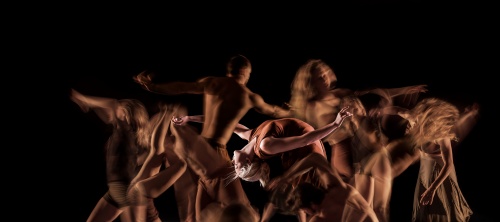|
 |
|
|
 |
 |
Circa, Brisbane, Australia’s contemporary circus company, under the artistic direction of Yaron Lifschitz, returned after a five-year hiatus to celebrate the tenth anniversary of Lincoln Center’s White Light Festival (October 19-November 24, 2019) with its U.S. premiere of “En Masse” (October 23-25). The company’s ten acrobats brought a level of energy, intensity, fearlessness and physical prowess that was unsurpassed. They were breathtaking and left the audience breathless. In the program’s director’s note, Lifschitz explained that the show’s two acts “[speaks] of fresh starts and old endings, of violence and tenderness, of groups and individuals, of destruction and of abundant hope.” All of which his exceptional choreography reflected. At the beginning of each act of the 90-minute production a quote flashed overhead. For Act I, “The crisis consists precisely in the fact that the old is dying and the new cannot be born,” by Antonio Gramsci, an Italian Marxist philosopher and communist politician, who died in 1937 at age 46 due to health complications related to harsh imprisonment. This part featured the troupe, tenor Robert Murray and pianist Michael Kieran Harvey performing selections from “Schwanengesang,” (“Swan Song”), a collection of songs, and “Winterreise” (“Winter Journey”), a song cycle for voice and piano, by 19th-century Austrian composer Franz Schubert, who died at age 31, alternating with contemporary music by 26-year-old Swedish composer Klara Lewis. There was a big plastic bubble in which the dancers were trapped, perhaps “unborn.” When some tried to escape by jumping at the wall, they were caught and held back. The performers climbed onto each other, crawled around, made various shapes on top of each other, formed a big pyramid balancing with ease and a bridge of bodies to walk across. After the final lone person exited, they all performed every death- and gravity-defying feat imaginable and then some, with each tumble, roll, flip, body pile-up, flying leap into another’s waiting arms or body, high jump and sky-high pyramid. Their movements were sometimes slow with a hint of aggression and fast with overt aggression. The back and forth of the two compositions gave depth and texture to the emotional landscape. Schubert was quieter in its intensity, while Lewis could be loud, aggressive and jarring, which the choreography reflected, including a series of recurrent twitchy-bouncy movements. Murray, dressed in peasant garb and holding a thick gnarly stick, sang magnificently throughout the piece, wandering the stage like an itinerant narrator. The quote for Act II was from German-Jewish philosopher Walter Benjamin, who either committed suicide while fleeing the Nazis or was killed by Stalinist agents in 1940. He said, “There is no document of civilization that is not at the same time a document of barbarism.” The acrobats were accompanied by the piano duet of Harvey and Tamara-Anna Cislowska performing Stravinsky’s intense “Le sacre du printemps” (The Rite of Spring”). The performers reacted to the intensity of Stravinsky’s jarring sections accordingly, especially with more twitching. In addition to the variations on their inexhaustible movement repertoire, there was an outstanding ever-changing multi-person balancing tableaux. Circa is a three-ring circus unto itself. Everywhere you looked, there was something amazing happening, with Lifschitz as the ultimate ringmaster.
 Circa in "En Masse". Photo © & courtesy of Damien Bredberg |
|
 Circa in "En Masse". Photo © & courtesy of Damien Bredberg |
|
 Circa in "En Masse". Photo © & courtesy of Damien Bredberg |
|
|
|




